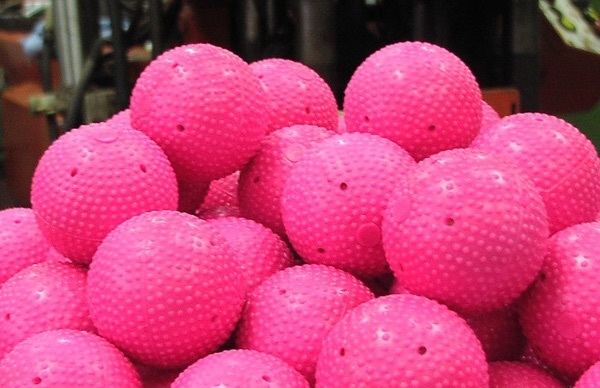 | ||
Rink bandy and rinkball are two very similar team sports, both developed from bandy but played on a significantly smaller ice rink. While a bandy rink is about the same size as a football pitch, rink bandy and rinkball are played on ice hockey rinks.
Contents
Rink bandy originated in Sweden in the 1960s and was originally called hockey-bockey. As indoor ice hockey arenas started coming, it was a way for bandy players to practice on ice a longer time of the year; as bandy fields are larger, they were still only made outdoors in the wintertime when artificial freezing was not necessary. Gradually rinkball developed as a sport of its own after being introduced to Finland later that decade.
Both games use a bandy ball, but in rinkball it is blue instead of cerise. Rink bandy uses bandy sticks and rinkball uses ice hockey sticks. The rink bandy goalkeeper has no stick, whereas the rinkball counterpart has. Similar to hockey, a game lasts 60 minutes, but is composed of either two 30 minute halves or three 20 minute periods. They use similar rules to normal bandy, but simplifies them to increase the pace of the game. Checking is prohibited, making the sport relatively safer than its relatives. Because of the smaller playing area, fewer players are used. Normally it's six a side. In the USA Rink Bandy League, five players are used because of the smaller ice hockey rinks there.
As artficially frozen and indoor bandy arenas has become more prevalent, the interest for rink bandy has dwindled in the main bandy countries (Russia, Sweden, Finland, Norway). In many countries where bandy is still new and the infrastructure for large ices is not in place, rink bandy is the main form of bandy.
Rink bandy
Rink bandy is governed by the Federation of International Bandy. In its quest for entering bandy to the programme of the Winter Olympics, rink bandy is an important way for the Federation of International Bandy to get more member countries, thus also spreading bandy, since some members without a large ice only play rink bandy at home but still participate in the Bandy World Championship.
With more and more indoor bandy arenas coming in Sweden, rink bandy subsequently becomes less interesting among Swedish bandy clubs. In Russia there are still several rink bandy tournaments. In Russian, the sport may be called either rink bandy (ринк-бенди) or mini bandy (мини-хоккею с мячом).
There used to be a European Championship. Today there is no international rink bandy championship. A world cup for rink bandy clubs was held every year from 1984-1998 in Hofors, Sweden. Rink bandy was in the programme of the 2012 European Company Sports Games. An international rink bandy club competition called Dniprobandy has been organised by the Ukrainian Bandy and Rink bandy Federation.
Rinkball
In the 1970s rinkball grew from being played in local tournaments by villagers around Finland to national-level competitions involving 100 teams or more. The sport first gained international attention in 1984 when teams from Finland and Sweden hosted one another. The International Rinkball Association was formed soon after, and in the late 1990s included Russia, Sweden, Kazakhstan, Estonia, Switzerland, Hungary, Finland and the United States. The Finnish Rinkball Federation has 1000 teams, including women, men and children. Play is divided into eight male divisions, two female divisions, and children's play is divided by age. The first World Championship Games for men was held in Omsk, Russia, in 1998.
The Rinkball League in Finland publishes a magazine called Liiga Extra, which offers international coverage of tournaments, equipment, and tips. In Finland, leagues and a national championship is held annually (as of 2016).
